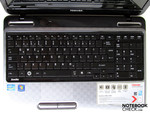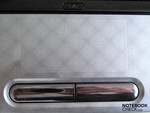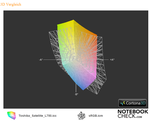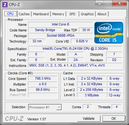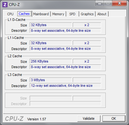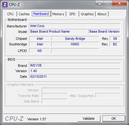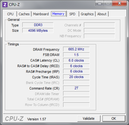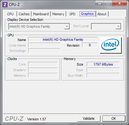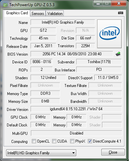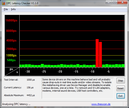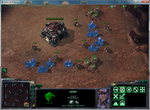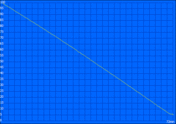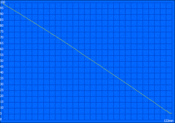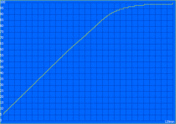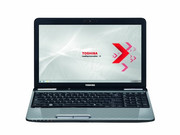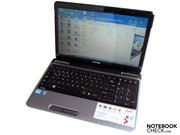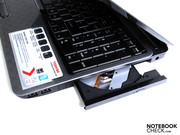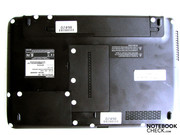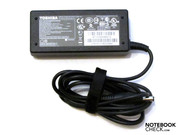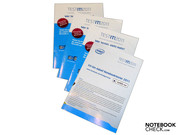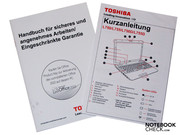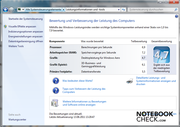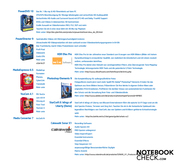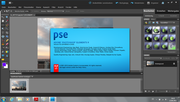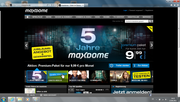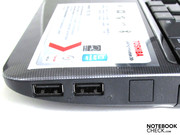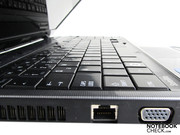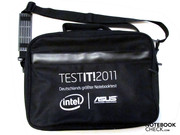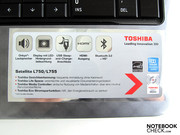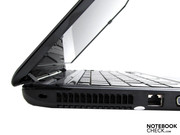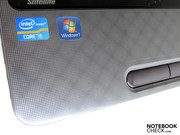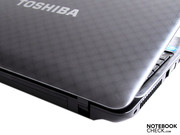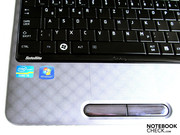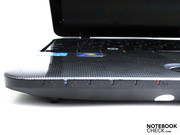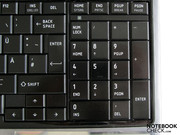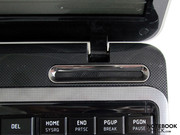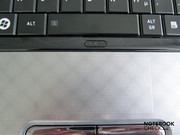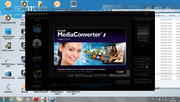Review Toshiba Satellite L755-14P Notebook

The Toshiba Satellite L755-14P is currently on the road as a participant of "TestIT2011, Germany's biggest notebook test". The notebook is equipped with a 15.6 inch screen and an Intel Core i5-2410M CPU so that it can be used in both an office environment as well as by consumers.
The processor's built-in graphics card is responsible for video output and - as the benchmarks prove - has enough power for the Satellite L755-14P's screen in many cases. Even a few new games are playable in a still acceptable graphics quality. However, the device's strengths are found in office, Internet and home applications. The Toshiba Satellite L755-14P has a price of about 700 euros.
Case
The Toshiba Satellite L755-14P's case makes a good impression at first sight. The lid's top shows a subtle pattern that can also be found on the wrist-rest. The plastic case is resistant to environmental influences, such as fingerprints or dust.
The lid, where the 15.6 inch screen is fitted, can be opened easily. Now it becomes obvious that the Toshiba Satellite L755-14P's workmanship has suffered a bit. The lid is held by two cheap-looking hinges that apparently aren't to last for several years of use. Every opening is accompanied by unpleasant noises. The lid teeters for a long time after it's opened. It can even happen that the lid clatters in a closed state - for example when the notebook is on the backseat while you're driving - and that the lid hits the wrist-rest. A closing mechanism would have been a sensible feature in this case.
Connectivity
Toshiba has put focus on the most vital in terms of ports. The rear and the front hardly have any interfaces. Only a card reader can be found on the front. 1 USB, headphone and microphone, 1 VGA and HDMI, 1 RJ45 (LAN) are on the left. You will find 2 USBs, the DVD burner and power socket on the right.
All three USB ports are only compatible with USB 2.0. Toshiba hasn't used USB 3.0 or eSATA in this device. The space between the single ports is generous. The Toshiba Satellite L755-14P is lopsided to the left when all ports are used because both VGA and HDMI are located here.
Communication
WiFi standard IEEE 802.11 b/g/n as well as Bluetooth 3.0 +HS take care of the connectivity in the Toshiba Satellite L755-14P. The notebook also has a FastEthernet socket for wired network connections (10BASE-T/100BASE-TX). This is more than sufficient for Internet connections. However, it is too slow for large scale company or internal home data exchange and shouldn't be installed any longer.
Security
Toshiba's notebook has a lot to offer in terms of security. There are a few tools pre-installed from the EasyGuard series. Among them, anti-virus software, password utilities, a BIOS with CompuTrace and a – extra charge – theft protection. Moreover, the device has a mandatory Kensington cable slot.
Supplies
Besides the installed operating system, Windows 7 Home Premium 64bit version, a vast amount of tools, applications and supplementary services are pre-installed on the Toshiba Satellite L755-14P. This can be an advantage for the user - that is if he finds really useful tools - but it slows down booting considerably. Experienced users would sooner call many programs annoying bloatware.
For example, there is access to the online video store, Maxdome, installed on our test laptop. A few movies and series can be watched directly via the Internet connection. Of course, Maxdome wants to get the notebook buyers to opt for a monthly subscription with that. The premium bundle can be ordered for 9.99 euros. Additional software bundles from Adobe, ArcSoft, Nero and Cyberlink finish off the package. Even Microsoft Office 2010 is installed as the Starter Edition (very restricted version) on the Satellite L755-14P.
Warranty
The warranty corresponds to the statutory two years in Germany. It includes an international bring-in manufacturer's warranty (Europe, Middle East, Africa) and an onsite pick-up service in Germany and Austria.
Input Devices
Keyboard
The Toshiba Satellite L755-14P's keyboard is standard and doesn't bid any noteworthy highlights. The number pad is located on the right of the slightly spongy-seeming key field. Many keys are additionally mapped with the FN key on this device despite the large number of keys (102). The legibility of symbols isn't satisfying. Toshiba has restrained itself from applying too much color on the keyboard layout in favor of looks. The size of the single keys is acceptable. Merely the left shift key could have been a bit bigger.
Touchpad
The touchpad is, as usual, in front of the keyboard. However, it is not easy to locate in the beginning because of the unusual small size and its implementation in the wrist-rest. The wrist-rest's pattern runs continuously over the touchpad and thus it needs a lot of practice to hit the slightly elevated area accurately. There are two huge looking mouse keys in front of the touchpad. Toshiba has equipped the touchpad with an off button above the touchpad.
Display
The manufacturer builds a 15.6 inch screen, model Toshiba TruBrite HD with LED backlight and an aspect ratio of 16:9), in this model.
The screen distributes the brightness evenly (90%). We could measure a maximum rate of 238 cd/m2 in the display's center. The brightness drops to 220 cd/m2 in the upper left.
The contrast turns out very low with 134:1 and can clearly be seen in the colors. The assessed black value is a high 1.77 cd/m2. The widescreen display doesn't display dark picture or video sequences in deep black, but rather with an evident gray cast. That even gets brighter towards the display's upper and lower edges (bleeding).
| |||||||||||||||||||||||||
Brightness Distribution: 90 %
Center on Battery: 238 cd/m²
Contrast: 134:1 (Black: 1.77 cd/m²)
50.5% AdobeRGB 1998 (Argyll 3D)
68% sRGB (Argyll 3D)
52.3% Display P3 (Argyll 3D)
The 15.6 incher doesn't exactly represent the perfect size for extended office applications (several windows adjacent). But it's ideal for surfing or writing emails. The resolution is 1366x768 pixels. A higher resolution can be accomplished over an external monitor over the VGA or HDMI port. A maximum of up to 2048x1536 is possible on an external TFT.
The Toshiba laptop's reflective 15.6 inch display shows a lot of its surroundings outdoors. The clouds in the sky can be seen better than the actual display content even without direct sunlight, as you can see clearly on our picture.
The Toshiba notebook's viewing angles are quite modest. The picture was still well visible from both sides without the contrast suffering in our mandatory lateral viewing angle of 45 degrees. An inverted, respectively faded picture was rendered in every setting with an additional tilting angle of the display.
Performance
The Intel Core i5-2410M, which is standardly clocked with 2.3 GHz, belongs to the Sandy Bridge processor generation and can be increased to a clock of 2.9 GHz with Turbo Boost. Overclocking happens automatically and is determined by the required performance in every case. In addition to both CPU core units there is also a 3 MB L3 cache and the incorporated HD Graphics 3000 on the processor's die. The front side bus (FSB) work with 1333 MHz in this system.
The CPU initially ran up to 2.9 GHz during the stress test. The maximum frequencies could be reached less frequently, the higher the temperatures climbed. It's great that the CPU doesn't throttle. That means that the CPU's clock didn't fall below 2.3 GHz (all four threads loaded).
CPU Performance
The benchmark results are on the expected level and don't show any outliers. The laptop achieved a score of 3699 points in Cinebench R10's single rendering (32 bit). It was 7946 (32 bit) and 9662 points (64 bit) in multi rendering.
Even the rates in the PCMark series were impressive. The achieved scores are on a par with the opponents in the 3DMark series' graphic benchmarks.
| PCMark 05 Standard | 7191 points | |
| PCMark Vantage Result | 5951 points | |
| PCMark 7 Score | 2090 points | |
Help | ||
GPU Performance
The DirectX 10 capable graphics unit, Intel HD Graphics 3000, is located directly in the Intel Core i5-2410M and shares the level 3, respectively the last level cache with the processor. The graphics performance is a lot better than in the older Intel HD Graphics and is on a par with an entry-level graphics card (for example, the Nvidia GeForce 310M). The Intel HD graphics is also dynamically clocked from 650 to 1200 MHz thanks to Turbo Boost.
The HD Graphics 3000's performance is for example seen in 3DMark 2006, where the Toshiba L755 scores accordingly for the configuration at hand with 3641 points. Intel's GMA HD predecessor only achieved about 1000 points in comparison.
Besides the classic office and multimedia tasks (video rendering), the performance even suffices for more demanding tasks, such as simple HD video editing or games in low graphic details.
| 3DMark 03 Standard | 7679 points | |
| 3DMark 05 Standard | 5881 points | |
| 3DMark 06 Standard Score | 3641 points | |
Help | ||
The installed 2.5 inch Toshiba hard disk reads with 68.4 MB/s in sequential read (HDTune). This rate was confirmed by the second test program, Crystal Disk Mark (63 MB/s). The built-in Toshiba hard disk is on the expected level of a common 5400 rpm memory with these results. However, even faster memory solutions are available. The access rate of only 17 ms (HDTune) has to be noted positively.
Verdict: Gaming
The processor's incorporated HD graphics is responsible for the video output. It is, thanks to the Sandy Bridge processor generation, more than sufficient for office applications, Internet surfing or flash games. But even not quite as graphics-heavy games are playable in an apt resolution and adjusted details.
The pre-installed game, StarCraft II, still ran fairly smoothly in 1360x768 and medium graphics quality. Other tested games first ran smoothly after optimizing the resolution and the detail level. The Toshiba L755-14P isn't recommendable as a gaming platform, though.
| low | med. | high | ultra | |
|---|---|---|---|---|
| StarCraft 2 (2010) | 65 | 21 | 13 | 8 |
| Mafia 2 (2010) | 7 | 19 | 15 | 9 |
| Fifa 11 (2010) | 98 | 54 | 32 | 23 |
| Call of Duty: Black Ops (2010) | 27 | 18 | 13 | 6 |
| Crysis 2 (2011) | 30 | 19 | 15 | 4 |
| Dirt 3 (2011) | 72 | 31 | 16 | 13 |
Emissions
System Noise
Our measured rates stayed agreeably low in use without load, but there nevertheless is a constant noise audible even in idle mode. It gets louder when the hardware is put under demand.
The background noise is over and done with during load. Our meter records up to 42 dB(A) then. This condition will hardly ever turn up during practical use, though. You will be dealing with an acceptable noise level most of the time.
Noise level
| Idle |
| 31.5 / 31.6 / 31.6 dB(A) |
| HDD |
| 32 dB(A) |
| DVD |
| 34.4 / dB(A) |
| Load |
| 37.8 / 42 dB(A) |
 | ||
30 dB silent 40 dB(A) audible 50 dB(A) loud |
||
min: | ||
Temperature
The bottom's average temperature is only about 27 degrees Celsius in idle mode. 28 degrees were partly surpassed. We measured an average temperature of 26 degrees on the top. However, up to 29 degrees were measured on the outer right.
The laptop case's bottom and top both get a lot warmer during load. The temperature partly increased by 8 degrees. The heat development on the left side increased a lot more than on the notebook's right. This indicates the CPU's location on the inside. The power adapter heated up to 45 degrees during applied load.
Overall, the Toshiba L755 never reached an unpleasant level and can thus also be used on the lap without hesitation.
(+) The maximum temperature on the upper side is 33.6 °C / 92 F, compared to the average of 34.3 °C / 94 F, ranging from 21.2 to 62.5 °C for the class Office.
(+) The bottom heats up to a maximum of 36 °C / 97 F, compared to the average of 36.8 °C / 98 F
(+) In idle usage, the average temperature for the upper side is 26 °C / 79 F, compared to the device average of 29.5 °C / 85 F.
(+) The palmrests and touchpad are cooler than skin temperature with a maximum of 29 °C / 84.2 F and are therefore cool to the touch.
(±) The average temperature of the palmrest area of similar devices was 27.6 °C / 81.7 F (-1.4 °C / -2.5 F).
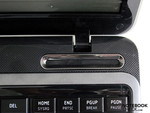
Speakers
Both installed stereo speakers are found above the keyboard's left and right. Sound rendering in games or during a DVD movie could convince. However, the laptop vibrated in time with the bass while playing loud music. You should use external speakers when you are planning to use the laptop as a "disco sound system".
Battery Life
The Toshiba Satellite L755-14P had to endure several battery runtime tests with a battery charged to 100 percent. The used lithium ion battery was fully charged after a loading period of 129 minutes. We determined a battery life of about 330 minutes in the practical WLAN surf test. However, it came to an end after only 122 minutes in DVD movie rendering (both balanced profile, adapted brightness).
The Toshiba L755 lasted for a maximum of over 7 hours in the most favorable conditions (minimum display brightness, WLAN off, energy saving profile) in the BatteryEater Reader's test. The battery was drained after 72 minutes in load (Classic test) and the notebook turned itself off.
Basically, the Toshiba L755 can score with attractive battery runtimes.
The Toshiba Satellite L755-14P's power consumption is low as long as the hardware isn't put under demand. The power consumption is 7.8 watts in idle mode and when all saving options of the notebook are enabled. We measured 11.7 watts with a brighter display and enabled wireless LAN (idle, max). This is still acceptable. The Toshiba Satellite L755-14P's maximum possible power consumption (without battery charging) is 54.7 watts (stress test).
| Off / Standby | |
| Idle | |
| Load |
|
Key:
min: | |
Verdict
The Toshiba Satellite L755-14P is an all-rounder that can find its workplace in both the office as well as in home field. The latest Core i5-2410M processor is well-equipped for all tasks with its 2.3 GHz and the turbo power reserves. The incorporated graphics from Intel has a very sufficient capacity for the 15.6 inch display in office use. The 500 GB hard disk is completely enough for saving data and applications. The existing 4 GB of RAM are also adequately dimensioned because a 64 bit operating system is installed. There is an empty DIMM slot in the device over which the RAM can be upgraded.
The Toshiba Satellite L755-14P's workmanship is partly unsatisfactory. The case clatters, the keyboard makes a spongy impression while typing and the display lid can't really be closed securely.
The power consumption is exemplary, the battery life remains within the expected range and is very dependent on the required performance in every single case.
With the Satellite L744-14P, Toshiba has created a strong office notebook in a cheap-looking case with an acceptable battery life. The recommended retail price is about 699 euros for the Satellite L755-14P.
Our reader and reporter René F. says:
The first time I held the Toshiba Satellite L755 in my hands, its weight and design fascinated me. I can call 10 laptops my own up to date. But none of them was a Toshiba.
I have had a Fujitsu Siemens, Acer or even an Asus until now. However, I can already say that none of these notebooks made such a positive first impression as this one here.
After turning it on, everything went quite fast. The notebook booted quite fast. I would say, it is in the standard range of notebooks that are as good as new.
I always have mixed feeling for the displays. I actually hate glossy displays because I like to work outside or in my winter garden and also do so. Of course, I have extreme light conditions there. No glossy display can score well there. That's why I bought a notebook with a matt display for myself. Naturally, everything has their pros and cons. Thus, the color brightness of a glossy display is naturally a lot superior to a matt display.
Now, I've taken a closer look at the ports. The only thing that bothered me here was that it only has three USB ports. I would have liked to see at least four. Three ports are quickly occupied nowadays. Mouse, cell phone, ext. hard disk, MP3 player, digicam, etc.
The processor is a second generation Intel Core i5. It has a clock rate of 2.3 GHz and can clock up to a maximum of 2.9 GHz with enabled turbo. Besides that, the Intel HD 3000 graphics chip is built into the CPU. It makes an additional graphics card superfluous unless you are a hardcore gamer. You can play many games fairly well with this built-in graphics chip. The chip is overburdened if you want more details (medium or maximum).
The RAM is fully sufficient with 4GB and gets along perfectly with the Intel Core i5 processor. The 500 GB hard disk is enough and is in the midfield (320 – 640 GB) in comparison to the capacities of similarly priced laptops.
The fan didn't start up during work (Word, Excel). It ran very quietly and almost silently while looking at pictures or watching videos. It only ran faster in games and was slightly annoying.
The sound system is from Onkyo. Its sound is clear and doesn't distort so that the combination of HD video graphics and sound is an experience where I sometimes favored the laptop to my old TV :-)









